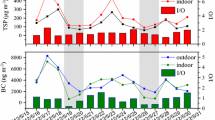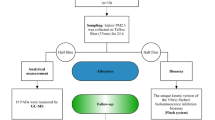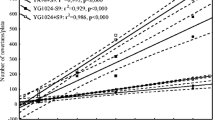Abstract
Polycyclic aromatic hydrocarbons (PAHs) attached to particulate matter can affect respiratory health, especially the health of children, but information on the air quality in schools is generally lacking. This study investigated the PAH concentrations in a naturally ventilated classroom in Xi’an, China, from 16 to 31 May 2012. Particulate PAH concentrations were measured for samples collected on five-stage cascade impactors deployed inside the classroom and outside. PM2.5-bound PAH concentrations were 53.2 ng m−3 indoors and 72.9 ng m−3 outdoors. PAHs attached to very fine particles (VFPs) accounted for ~70 % of the total PAHs. The PAH concentrations indoors were affected by the students’ activities, cleaning, and smoking, while outdoors, the main sources were motor vehicle emissions and contaminated road dust. Particle-bound PAHs infiltrated the classroom through open windows, but the activities of the students and staff were also associated with an increase of PAHs attached to particles larger than 1.0 µm, most likely through resuspension. Cycles in the sources led to PAH concentrations 2–3 times higher on weekdays compared to weekends, both indoors and outdoors. PAH toxicity risks inside the classroom were substantially lower than those outdoors, and the highest risks were associated with VFPs.





Similar content being viewed by others
References
Allen, J. O., Dookeran, N. M., Smith, K. A., & Sarofim, A. F. (1996). Measurement of polycyclic aromatic hydrocarbons associated with size-segregated atmospheric aerosols in Massachusetts. Environmental Science and Technology, 30(3), 1023–1031.
Almeida, S. M., Canha, N., Silva, A., Freitas, M. C., Pegas, P., Alves, C., et al. (2011). Children exposure to atmospheric particles in indoor of Lisbon primary schools. Atmospheric Environment, 45(10), 7594–7599.
Alshitawi, M. S., & Awbi, H. B. (2011). Measurement and prediction of the effect of students’ activities on airborne particulate concentration in a classroom. International Journal of HVAC&R Research, 17(4), 446–464.
Bennett, W. D., & Zeman, K. L. (1998). Deposition of fine particles in children spontaneously breathing at rest. Inhalation Toxicology, 10, 831–842.
Bi, X. H., Sheng, G. Y., Peng, P. A., Chen, Y. J., Zhang, Z. Q., & Fu, J. M. (2003). Distribution of particulate- and vapor-phase n-alkanes and polycyclic aromatic hydrocarbons in urban atmosphere of Guangzhou, China. Atmospheric Environment, 37(2), 289–298.
Bull, S., & Collins, C. (2013). Promoting the use of BaP as a marker for PAH exposure in UK soils. Environmental Geochemistry and Health, 35, 101–109.
Cao, J. J., Lee, S. C., Chow, J. C., Watson, J. G., Ho, K. F., Zhang, R. J., et al. (2007). Spatial and seasonal distributions of carbonaceous aerosols over China. Journal of Geophysical Research 112, D22S11.
Cao, J. J., Wu, F., Chow, J. C., Lee, S. C., Li, Y., Chen, S. W., et al. (2005). Characterization and source apportionment of atmospheric organic and elemental carbon during fall and winter of 2003 in Xi’an, China. Atmospheric Physics and Chemistry, 5, 3127–3137.
Cao, J. J. Zhu, C. S., Tie, X. X., Geng, F. H., Xu, H. M., Ho, S. S. H., et al. (2013). Characteristics and sources of carbonaceous aerosols from Shanghai, China. Atmospheric Chemistry and Physics, 13, 803–817.
Castro, D., Slezakova, K., Delerue-Matos, C., Alvim-Ferraz, M. C., Morais, S., & Pereira, M. C. (2011). Polycyclic aromatic hydrocarbons in gas and particulate phases of indoor environments influenced by tobacco smoke: Levels, phase distributions, and health risks. Atmospheric Environment, 459(10), 1799–1808.
Chow, J. C., Yu, J. Z., Watson, J. G., Ho, S. S. H., Bohannan, T. L., Hays, M. D., et al. (2007). The application of thermal methods for determining chemical composition of carbonaceous aerosols: A review. Journal of Environmental Science and Health, Part A, 42(11), 1521–1541.
Crist, K. C., Liu, B., Kim, M., Deshpande, S. R., & John, K. (2008). Characterization of fine particulate matter in Ohio: Indoor, outdoor, and personal exposures. Environmental Research, 106(1), 62–71.
Daisey, J. M., Angell, W. J., & Apte, M. G. (2003). Indoor air quality, ventilation and health symptom in schools: Analysis of existing information. Indoor Air, 13(1), 53–64.
Diapouli, E., Chaloulakou, A., Mihalopoulos, N., & Spyrellis, N. (2008). Indoor and outdoor PM mass and number concentrations at schools in the Athens area. Environmental Monitoring and Assessment, 136(1–3), 128–136.
Dockery, D. W., & Spengler, J. D. (1981). Indoor–outdoor relationships of respirable sulfates and particles. Atmospheric Environment, 15, 335–343.
Fromme, H., Diemer, J., Dietrich, S., Cyrys, J., Heinrich, J., Lang, W., et al. (2008). Chemical and morphological properties of particulate matter (PM10, PM2.5) in school classrooms and outdoor air. Atmospheric Environment, 42(27), 597–660.
GB/T18883-2002. (2002). Indoor air quality standards in China. Ministry of Environmental Protection and General Administration of Quality Supervision, Inspection and Quarantine of the People’s Republic of China.
GB3095-2012. (2012). Ambient air quality standards in China. Ministry of Environmental Protection and General Administration of Quality Supervision, Inspection and Quarantine of the People’s Republic of China.
Gemenetzis, P., Moussas, P., Arditsoglou, A., & Samara, C. (2006). Mass concentration and elemental composition of indoor PM2.5 and PM10 in university rooms in Thessaloniki, northern Greece. Atmospheric Environment, 40(17), 3195–3206.
Guo, H., Morawska, L., He, C. R., Zhang, Y. L., Ayoko, G., & Cao, M. (2010). Characterization of particle number concentrations and PM2.5 in a school: Influence of outdoor air pollution on indoor air. Environmental Science and Pollution Research International, 17(6), 1268–1278.
Heudorf, U., Neitzert, V., & Spark, J. (2009). Particulate matter and carbon dioxide in classrooms—the impact of cleaning and ventilation. International Journal of Hygiene and Environmental Health, 212(1), 45–55.
Ho, S. S. H., Chow, J. C., Watson, J. G., Ng, L. P. T., Kwok, Y., Ho, K. F., et al. (2011). Precautions for in-injection port thermal desorption-gas chromatography/mass spectrometry (TD-GC/MS) as applied to aerosol filter samples. Atmospheric Environment, 45(7), 1491–1496.
Ho, K. F., Ho, S. S. H., Lee, S. C., Cheng, Y., Chow, J. C., Watson, J. G., et al. (2009). Emissions of gas- and particle-phase polycyclic aromatic hydrocarbons (PAHs) in the Shing Mun Tunnel, Hong Kong. Atmospheric Environment, 43(40), 6343–6351.
Ho, S. S. H., & Yu, J. Z. (2004). In-injection port thermal desorption and subsequent gas chromatography-mass spectrometric analysis of polycyclic aromatic hydrocarbons and n-alkanes in atmospheric aerosol samples. Journal of Chromatography A, 1059(1–2), 121–129.
Ho, S. S. H., Yu, J. Z., Chow, J. C., Zielinska, B., Watson, J. G., Sit, E. H. L., et al. (2008). Evaluation of an in-injection port thermal desorption-gas chromatography/mass spectrometry method for analysis of non-polar organic compounds in ambient aerosol samples. Journal of Chromatography A, 1200(2), 217–227.
Huang, H., Cao, J. J., Lee, S. C., Zou, C. W., Chen, X. G., & Fan, S. J. (2007). Spatial variation and relationship of indoor/outdoor PM2.5 at residential homes in Guangzhou city, China. Aerosol and Air Quality Research, 7(4), 518–530.
INCA. (2009). INCA Comparative Tables (Online). International Review of Curriculum and Assessment Framework Internet Archive (INCA), London.
Janssen, N. A. H., van Vliet, P. H. N., Aaarts, F., Harssema, H., & Brunekreef, B. (2001). Assessment of exposure to traffic related air pollution of children attending schools near motorways. Atmospheric Environment, 35, 3875–3884.
John, K., Karnae, S., Crist, K., Kim, M., & Kulkarni, A. (2007). Analysis of trace elements and ions in ambient fine particulate matter at three elementary schools in Ohio. Journal of the Air and Waste Management Association, 57(4), 394–406.
Kulkarni, N., & Grigg, J. (2008). Effect of air pollution on children. Journal of Paediatrics and Child Health, 18, 238–243.
Lai, A. C. K. (2002). Particle deposition indoors: A review. Indoor Air, 12(4), 211–214.
Lee, S. C., & Chang, M. (2000). Indoor and outdoor air quality investigation at schools in Hong Kong. Chemosphere, 41(1–2), 109–113.
Li, C. L., Fu, J. M., Sheng, G. Y., Bi, X. H., Hao, Y. M., Wang, X. M., et al. (2005). Vertical distribution of PAHs in the indoor and outdoor PM2.5 in Guangzhou, China. Building and Environment, 40(3), 329–341.
Liu, F., Liao, C. Y., Fu, J. J., Lv, J. G., Xue, Q. Z., & Jiang, G. B. (2013). Polycyclic aromatic hydrocarbons and organochlorine pesticides in rice hull from a typical e-waste recycling area in southeast China: Temporal trend, source, and exposure assessment. Environmental Geochemistry and Health, 36(1), 65–77.
Masih, J., Masih, A., Kulshrestha, A., Singhvi, R., & Taneja, A. (2010). Characteristics of polycyclic aromatic hydrocarbons in indoor and outdoor atmosphere in the North central part of India. Journal of Hazardous Materials, 177(1–3), 190–198.
Mendell, M. J., & Heath, G. A. (2005). Do indoor pollutants and thermal conditions in schools influence student performance? A critical review of the literature. Indoor Air, 15(1), 27–52.
Nisbet, I. C. T., & Lagoy, P. K. (1992). Toxic equivalency factors (TEFs) for polycyclic aromatic hydrocarbons (PAHs). Regulatory Toxicology and Pharmacology, 16(3), 290–300.
Okuda, T., Okamoto, K., Tanaka, S., Shen, Z. X., Han, Y. M., & Huo, Z. Q. (2010). Measurement and source identification of polycyclic aromatic hydrocarbons (PAHs) in the aerosol in Xi’an, China, by using automated column chromatography and applying positive matrix factorization (PMF). Science of the Total Environment, 408, 1909–1914.
Pegas, P. N., Nunes, T., Alves, C. A., Silva, J. R., Vieira, S. L. A., Caseiro, A., et al. (2012). Indoor and outdoor characterization of organic and inorganic compounds in city centre and suburban elementary schools of Aveiro, Portugal. Atmospheric Environment, 55, 80–89.
Petry, T., Schmid, P., & Schlatter, C. (1996). The use of toxic equivalency factors in assessing occupational and environmental health risk associated with exposure to airborne mixtures of polycyclic aromatic hydrocarbons (PAHs). Chemosphere, 32(4), 639–648.
Pope, C. A., Burnett, R. T., Thun, M. J., Calle, E. E., Krewski, D., Ito, K., et al. (2002). Lung cancer, cardiopulmonary mortality, and long-term exposure to fine particulate air pollution. The Journal of the American Medical Association, 287(9), 1132–1141.
Pope, C. A., & Dockery, D. W. (2006). Health effects of fine particulate air pollution: Lines that connect. Journal of the Air and Waste Management Association, 56(6), 709–742.
Remer, L. A., Chin, M., DeCola, P., Fein-gold, G., Halthore, R., Kahn, R. A., et al. (2009). Atmospheric aerosol properties and climate impacts: Aerosols and their climate effects, 1–2. U.S. Climate Change Science Program Synthesis and Assessment Product 2.3.
Schauer, C., Niessner, R., & Pöschl, U. (2003). Polycyclic aromatic hydrocarbons in urban air particulate matter: Decadal and seasonal trends, chemical degradation, and sampling artifacts. Environmental Science and Technology, 37, 2861–2868.
Seinfeld, J. H., & Pandis, S. N. (2006). Atmospheric chemistry and physics: From air pollution to climate change. New York: Wiley.
Shen, Z. X., Arimoto, R., Cao, J. J., Zhang, R. J., Li, X. X., Du, N., et al. (2008). Seasonal variations and evidence for the effectiveness of pollution controls on water-soluble inorganic species in total suspended particulates and fine particulate matter from Xi’an, China. Journal of the Air & Waste Management Association, 58(12), 1560–1570.
Shen, Z. X., Cao, J. J., Arimoto, R., Han, Z. W., Zhang, R. J., Han, Y. M., et al. (2009b). Ionic composition of TSP and PM2.5 during dust storms and air pollution episodes at Xi’an, China. Atmospheric Environment, 43(18), 2911–2918.
Shen, Z. X., Cao, J. J., Liu, S. X., Zhu, C. S., Wang, X., Zhang, T., et al. (2011). Chemical composition of PM10 and PM2.5 collected at ground level and 100 meters during a strong winter-time pollution episode in Xi’an, China. Journal of the Air & Waste Management Association, 61, 1150–1159.
Shen, Z. X., Cao, J. J., Tong, Z., Liu, S. X., Reddy, L. S. S., Han, Y. M., et al. (2009a). Chemical characteristics of submicron particles in winter in Xi’an. Aerosol and Air Quality Research, 9(1), 80–93.
Shen, Z. X., Cao, J. J., Zhang, L. M., Liu, L., Zhang, Q., Li, J. J., et al. (2014). Day-night differences and seasonal variations of chemical species in PM10 over Xi’an, northwest China. Environmental Science and Pollution Research, 21, 3697–3705.
Shen, Z. X., Han, Y. M., Cao, J. J., Tian, J., Zhu, C. S., Liu, S. X., et al. (2010). Characteristics of traffic-related emissions: A case study in roadside ambient air over Xi’an, China. Aerosol and Air Quality Research, 10, 292–300.
Shibamoto, T. (1998). Chromatographic analysis of environmental and food toxicants. New York: Marcel Dekker Inc.
Slezakova, K., Castro, D., Pereira, M. C., Morais, S., Delerue-Matos, C., & Alvim-Ferraz, M. C. (2009). Influence of tobacco smoke on carcinogenic PAH composition in indoor PM10 and PM2.5. Atmospheric Environment, 43(40), 6376–6382.
Tan, J. H., Guo, S. J., Ma, Y. L., Duan, J. C., Cheng, Y., He, K. B., et al. (2011). Characteristics of particulate PAHs during a typical haze episode in Guangzhou, China. Atmospheric Research, 102(1–2), 91–98.
Thatcher, T. L., & Layton, D. W. (1995). Deposition, resuspension and penetration of particles within a residence. Atmospheric Environment, 29(13), 1487–1497.
Tippayawong, N., Khuntong, P., Nitatwichit, C., Khunatorn, Y., & Tantakitti, C. (2009). Indoor/outdoor relationships of size-resolved particle concentrations in naturally ventilated school environments. Building and Environment, 44(1), 188–197.
Tiwari, M., Sahu, S. K., Bhangare, R. C., Ajmal, P. Y., & Pandit, G. G. (2013). Estimation of polycyclic aromatic hydrocarbons associated with size segregated combustion aerosols generated from household fuels. Microchemical Journal, 106, 79–86.
Tobiszewski, M., & Namiesnik, J. (2012). Review: PAH diagnostic ratios for the identification of pollution emission sources. Environmental Pollution, 162, 110–119.
Tran, D. T., Alleman, L. Y., Coddeville, P., & Galloo, J.-C. (2012). Elemental characterization and source identification of size resolved atmospheric particles in French classrooms. Atmospheric Environment, 54, 250–259.
Van Drooge, B. L., Nikolova, I., & Ballesta, P. P. (2009). Thermal desorption gas chromatography mass spectrometry as an enhanced method for the quantification of polycyclic aromatic hydrocarbons from ambient air particulate matter. Journal of Chromatography A, 1216(18), 4030–4039.
Wang, G. H., Kawamura, K., Lee, S. C., Ho, K. F., & Cao, J. J. (2006). Molecular, seasonal, and spatial distributions of organic aerosols from fourteen Chinese cities. Environment Science and Technology, 40(15), 4619–4625.
Ward, T. J., Noonan, C. W., & Hooper, K. (2007). Results of an indoor size fractionated PM school sampling program in Libby, Montana. Environmental Monitoring and Assessment, 130(1–3), 163–171.
WHO. (1998). World Health Organization, environmental health criteria 202: Selected non-heterocyclic polycyclic aromatic hydrocarbons. Geneva: World Health Organization.
WHO. (2000). World Health Organization, guideline for air quality. Geneva: World Health Organization.
Wolkoff, P., Wilkins, C. K., Clausen, P. A., & Nielsen, G. D. (2006). Organic compounds in office environments: Sensory irritation, odor, measurements and the role of reactive chemistry. Indoor Air, 16(1), 7–19.
Xu, H. M., Tao, J., Ho, S. S. H., Ho, K. F., Cao, J. J., Li, N., et al. (2013). Characteristics of fine particulate non-polar organic compounds in Guangzhou during the 16th Asian Games: Effectiveness of air pollution controls. Atmospheric Environment, 76, 94–101.
Yu, C., & Crump, D. (1998). A review of the emission of VOCs from polymeric materials used in buildings. Building and Environment, 33(6), 357–374.
Yu, H., & Yu, J. Z. (2011). Size distributions of polycyclic aromatic hydrocarbons at two receptor sites in the Pearl River Delta region, China: Implications of a dominant droplet mode. Aerosol Science and Technology, 45(1), 101–112.
Zhang, Q., & Zhu, Y. (2012). Characterizing ultrafine particles and other air pollutants at five schools in South Texas. Indoor Air, 22(1), 33–42.
Acknowledgments
This study was supported by the Shaanxi program (2012KTZB03-01) and a project of the International (Regional) Cooperation and Exchange Projects, Research Fund for International Young Scientists of the Chinese Academy of Sciences (grant no. 41150110474). This study was also supported by the New Teachers’ Scientific Research Support Plan of Xi’an Jiaotong University (XJTU-HRT-002) and the Fundamental Research Funds for the Central Universities.
Author information
Authors and Affiliations
Corresponding authors
Rights and permissions
About this article
Cite this article
Xu, H., Guinot, B., Niu, X. et al. Concentrations, particle-size distributions, and indoor/outdoor differences of polycyclic aromatic hydrocarbons (PAHs) in a middle school classroom in Xi’an, China. Environ Geochem Health 37, 861–873 (2015). https://doi.org/10.1007/s10653-014-9662-z
Received:
Accepted:
Published:
Issue Date:
DOI: https://doi.org/10.1007/s10653-014-9662-z




